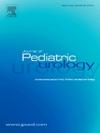上尿路扩张是原发性膀胱输尿管反流患儿发热性尿道炎的独立危险因素。
IF 2
3区 医学
Q2 PEDIATRICS
引用次数: 0
摘要
背景:众所周知,患有膀胱输尿管反流(VUR),尤其是高位VUR的儿童患尿路感染(UTI)的风险更高。目前的指南强调了治疗 VUR 儿童的某些临床因素;然而,在 VUR 的情况下进行上尿路扩张的临床效用仍不明确:本研究旨在评估现代队列中原发性 VUR 患儿发热性 UTI(fUTI)的风险因素,重点是上尿路扩张参数,包括肾积水和肾积水:方法:对一家学术机构自 2013 年 7 月至 2023 年 2 月期间前瞻性维护的 VUR 患儿数据库进行了审查。纳入了人口统计学和临床数据。回顾了最接近初始 VCUG 的超声波检查,以了解上尿路扩张情况,包括是否存在肾积水、胎儿泌尿外科学会 (SFU) 肾积水分级、是否存在肾积水以及肾盂前后直径 (APRPD)。主要研究结果是确诊 VUR 后发生肛瘘。患者在首次发生膀胱尿道炎或进行 VUR 手术后即被淘汰:共对 235 名患有原发性 VUR 的儿童进行了评估,其中包括 125 名女性(53.2%)和 110 名男性(46.8%)。确诊 VUR 的中位年龄为 10.8 个月(IQR:2.3-63.6 个月)。共有 41 名儿童(17.4%)在确诊 VUR 后出现肛瘘,中位随访时间为 2.3 年(IQR:0.9-4.6 年)。单变量分析发现,与咽峡炎相关的变量包括年龄:上尿路扩张是原发性膀胱尿道炎患儿发生膀胱尿道炎的一个新的、独立的风险因素,其中APRPD是最强的预测因素。临床医生在对原发性 VUR 患儿进行个体化治疗时,除了考虑年龄、性别和 VUR 分级外,还可考虑上尿路扩张参数。本文章由计算机程序翻译,如有差异,请以英文原文为准。
Upper tract dilation is an independent risk factor for febrile UTI in children with primary vesicoureteral reflux
Background
Children with vesicoureteral reflux (VUR), particularly high-grade VUR, are known to be at increased risk for urinary tract infection (UTI). Current guidelines highlight certain clinical factors in the management of children with VUR; however, the clinical utility of upper tract dilation in the setting of VUR remains unclear.
Objective
The purpose of this study is to evaluate risk factors for febrile UTI (fUTI) in children with primary VUR in a modern cohort with emphasis on upper tract dilation parameters, including hydronephrosis and hydroureter.
Methods
A prospectively maintained database of children with VUR at a single academic institution from July 2013 to February 2023 was reviewed. Demographic and clinical data were included. Ultrasounds closest to initial VCUG were reviewed for upper tract dilation, including the presence of hydronephrosis, Society of Fetal Urology (SFU) hydronephrosis grade, presence of hydroureter, and anterior-posterior renal pelvic diameter (APRPD). The primary outcome of interest was the development of a fUTI after VUR diagnosis. Patients were censored after their first fUTI or after VUR surgery.
Results
A total of 235 children with primary VUR were evaluated, including 125 (53.2 %) females and 110 (46.8 %) males. The median age of VUR diagnosis was 10.8 months (IQR: 2.3–63.6 months). A total of 41 (17.4 %) children developed a fUTI after VUR diagnosis with a median follow up of 2.3 years (IQR: 0.9–4.6 years). On univariate analysis, variables found to be associated with fUTI included age <1 year at VUR diagnosis (p = 0.021), female sex (p = 0.013), high-grade VUR (p = 0.024), APRPD ≥7 mm (p = 0.007), high-grade hydronephrosis (p = 0.004), presence of hydronephrosis (p = 0.029), and hydroureter (p = 0.008). In children with VUR and high-grade hydronephrosis, a larger APRPD was associated with higher fUTI rates (p = 0.008). On multivariate analysis controlling for age, sex, and VUR grade, APRPD ≥7 mm (OR 2.8, p = 0.009), high-grade hydronephrosis (OR 2.5, p = 0.025), and presence of hydronephrosis (OR 2.3, p = 0.049) were independent risk factors for fUTI. On multivariate models controlling for other upper tract dilation parameters, APRPD ≥7 mm was the most significant parameter associated with increased fUTI risk in primary VUR.
Conclusion
Upper tract dilation is a novel, independent risk factor for fUTI in children with primary VUR, with APRPD being the strongest predictor. Clinicians may consider upper tract dilation parameters in addition to age, sex, and VUR grade when individualizing care in children with primary VUR.
求助全文
通过发布文献求助,成功后即可免费获取论文全文。
去求助
来源期刊

Journal of Pediatric Urology
PEDIATRICS-UROLOGY & NEPHROLOGY
CiteScore
3.70
自引率
15.00%
发文量
330
审稿时长
4-8 weeks
期刊介绍:
The Journal of Pediatric Urology publishes submitted research and clinical articles relating to Pediatric Urology which have been accepted after adequate peer review.
It publishes regular articles that have been submitted after invitation, that cover the curriculum of Pediatric Urology, and enable trainee surgeons to attain theoretical competence of the sub-specialty.
It publishes regular reviews of pediatric urological articles appearing in other journals.
It publishes invited review articles by recognised experts on modern or controversial aspects of the sub-specialty.
It enables any affiliated society to advertise society events or information in the journal without charge and will publish abstracts of papers to be read at society meetings.
 求助内容:
求助内容: 应助结果提醒方式:
应助结果提醒方式:


